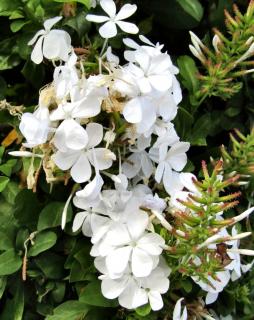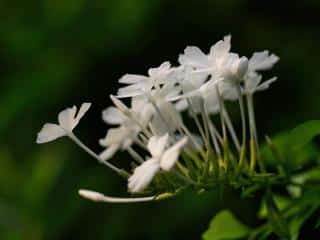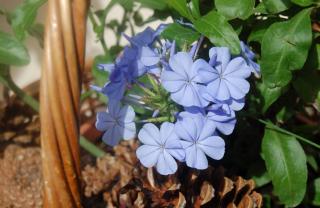

Love Plumbago but no garden to set it loose? The Escapade series is perfect for pots!
Key Plumbago Escapade facts
Name – P. auriculata ‘Escapade’
Family – Plumbaginaceae
Type – shrub
Height – 3 to 5 ½ feet (up to 1.8 m)
In Pots – 1½ to 2½ feet (45 to 70 cm)
Soil – rich, slightly acidic
Exposure: full sun – Foliage: semi-evergreen – Blooming: end spring → mid-fall
With blue or pearl white blooms, the Escapade series is a sure option for a balcony!
The most important factor regarding the soil and planting is drainage. The ground must drain very well and water shouldn’t pool for more than a few minutes when you’re watering.
Plumbago Escapade seeds can be purchased online, about 2500 seeds per ounce (85 seeds to a gram). Germination rate reaches 90% if seeds were stored properly.

The best way to make sure any new plants are identical to the mother plant is to perform plumbago cuttings.
However, there are other propagation methods for plumbago. These include sowing and even layering, for instance.
This variety doesn’t resist frost very well. If you want to give it a head start in spring, keep it in a cool greenhouse or lean-in that doesn’t freeze over the winter.
It can sprout back if temperatures fall to the lower 20s°F (-7°C) but only for a few days with dry soil.
Full sun! Definitely a lover of sun. Feel free to give it as much sun as you can.
Your ‘Escapade’ plumbago will resist both heat and drought very well.
However, to decrease risk of dying off and to reduce the need for watering even further, remember to spread mulch around the foot of the plant. This helps lock moisture in.

If the soil is poor, it’ll grow just fine but blooming won’t be as impressive.
Add regular balanced fertilizer every two weeks when the plant starts blooming. Make your own from early weeds such as comfrey tea.
In temperate climates, this plant might lose its leaves during bouts of cold, but they’ll come back in spring.
Usually, wherever winters are cold, dieback will occur almost all the way back to the base.
Once sprigs have grown to about foot (30 cm), pinch or cut each sprig by around 5 inches (12-13 cm). This will trigger branching out and you’ll double the number of flowers!
You’ll encounter aphids at the beginning of the season, and possibly thrips a bit later on.
Other than that, overwatering is the only risk to the plant, but this is only a concern if the soil doesn’t drain well.
If deer tend to visit your patio, don’t worry: they won’t find this plumbago very appealing.

Feel free to plant several of them side by side at a distance of about 8 inches (20 cm) in order to provide for excellent ground cover.
There are two varieties of Plumbago auriculata ‘Escapade’:
The Escapade series is a first-generation hybrid. Seeds will appear and self-sow in following years, but may look different from the parent plant.
It’s gotten a bit more difficult to get a hold of seeds for these varieties. They were first put on the market around 2005.
Though bees and hummingbirds will appear interested in your Plumbago escapades, the true clients of this nectar open bar are butterflies. It’s one of the plants they love most!
This is surely the best of the blue plumbago varieties to plant in containers. You can even try growing it in hanging suspensions.